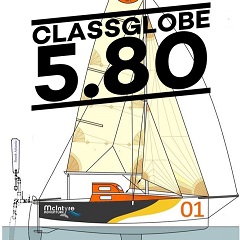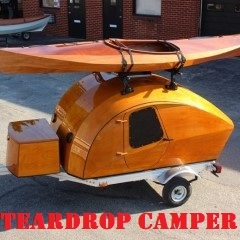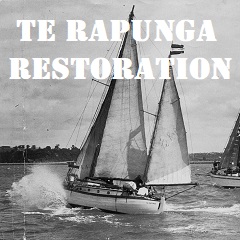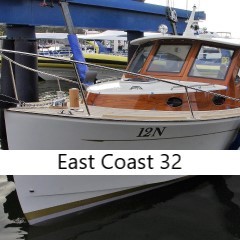Working with Epoxy Resin
Denman Marine's hints and tips for working with epoxy
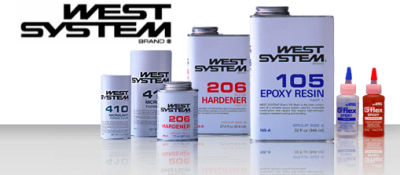
The first and most important thing to know about epoxies is that they are chemicals that can cause allergic sensitisation in people from over-exposure. Generally once you are sensitised there is no going back and there are hundreds of stories from people who can't work with epoxy anymore. I don't mean to be alarmist but if you take some basic precautions you shouldn't have a problem.
Whenever working with epoxies follow the manufacturer's material safety data sheet and keep the epoxy off your skin and the vapours out of your lungs. This means wearing a good quality chemical respirator and using good quality nitrile based gloves. Do not use the disposable gloves you buy at the supermarket as they let the epoxy through and onto your skin.
At Denman Marine we use Sundstrom brand respirators which are really comfortable. We also use Mediflex MX12 heavy duty long cuff nitrile disposable gloves and change them regularly on longer jobs.
Epoxy resins are generally pretty easy to work with and most of the problems people have with using them come from;
- incorrect mix ratios
- mixing in contaminated containers
- not mixing the product thoroughly enough before use
- using the wrong hardener for the conditions
- applying epoxy to greasy/oily timbers
- amine blush and secondary bonding
Lets have a brief look at these in turn.
Mixing ratios
We use WEST System brand epoxy and like most epoxies can be mixed either by weight or volume and in this case the ratio is the same - 5 parts epoxy to 1 part hardener (when using their standard 205 fast or 206 slow hardener).
Whilst you can buy pumps to dispense the epoxy, we have found that over time the pumps can get out of calibration, gum up due to the viscosity of the resin/hardener and not raise fully only dispensing partial pumps which throws out the all-important 5:1 ratio (especially evident in cooler climates). This also results in a slow pump action (taking forever to return to the top of the stroke), not to mention it being easy to get distracted when dispensing and forgetting how many pumps you have put into the container.
A much easier way to dispense is by weight. We use, and supply with the kits, small digital scales (5kg capacity) to weigh the epoxy and keep a mixing chart on the epoxy hot box that tells us exactly how much resin and how much hardener is required for a total mix volume. Simple, accurate, and effective.
Containers
Whilst it can be tempting to re-use dog food tins, margarine containers etc, there can be residual product in the containers that can affect the epoxy. We use plastic take away food containers as they are cheap, clean and have smooth sides so the epoxy can be mixed thoroughly. You can buy a sleeve of 50 or a box of 500+ and the most useful ones are the round ones designated BS20 and BS30 or similar. A box of 500 will set you back about $60.
Mixing
You should pay special attention when mixing the epoxy to ensure the sides of the container are scraped down and that the mix is thoroughly combined before using. Stir the resin and hardener together thoroughly, at least one minute, longer in cooler temperatures. To assure thorough mixing, scrape the sides and bottom of the pot as you mix. Use a square-ended mixing stick to reach the inside corner of the pot. If you are using a power mixer, occasionally scrape the sides and corners of the mixing pot while mixing.
The right hardener
Most epoxy systems will have hardeners for warmer weather and some for cooler conditions. These hardeners will have a lower temperature range that they will not cure below. West System 205 fast hardener is good for ambient cures down to 4 degrees Celsius and 206 slow hardener down to 16 degrees. You can use this to your advantage when adjusting cure times. We get pretty cold in Tassie during winter but we do not stop using epoxy. The main hardener we use in winter is 205 fast hardener but we will also use 206 slow in winter on larger glue ups to give a longer working time and then apply supplemental heat to raise the epoxy to the cure temperature.
Oily timbers
Oily timbers such as teak, Huon pine and white beech can be difficult to glue with epoxy. The key is to prepare the surface properly prior to gluing to ensure success. We "key" up the surface with an old saw blade and then wipe the surface down a couple of times with acetone and a clean rag around 5-10 minutes before glue up. This removes the surface oil and the keyed surface promotes mechanical bonding.
Amine Blush and secondary bonding
Amine blush is a by-product of the epoxy curing process and it is a waxy film that forms on the surface of the epoxy during cure. It is more prevalent in cooler/humid conditions. The blush will clog sandpaper so if in doubt, try sanding the cured epoxy with some 80 grit and if the paper clogs with a waxy substance you have blush. Luckily it is easy to remove with some plain warm water and a scotch brite pad. Some scrubbing and wiping down with paper towels or clean rags will remove it although sometimes you will need to go through the process a few times to ensure it is all gone. If you are secondary bonding anything to the cured epoxy then give the area a sand with 80 grit sandpaper after de-blushing to key the cured epoxy and allow optimal bonding between layers.
For those using WEST System, you can view the Gougeon Brothers book on Wood Epoxy boat construction as a downloadable .PDF file
http://www.westsystem.com/ss/assets/HowTo-Publications/GougeonBook%20061205.pdf
This book is the "Bible" on Wood/Epoxy boat building and is well worth reading for any project.
Other Tips
- Clean up - use methylated spirits to clean uncured epoxy off tools and the job (not off your skin!) If the epoxy has cured, use a heat gun to warm the cured resin and scrape off with triangular paint scraper.
- Filleting tools - The best filleting tools give a clean, crisp edge to the fillet making clean up a lot easier. We use metal flat blade paint scrapers for our filleting tools and a set will last you a lifetime. You will need a few of them for various fillet radii and it is easy to file/grind the radius on them. If you forget to clean them up you can apply a little heat from a heat gun and the epoxy comes off easily.
- Epoxy and fibreglass cloth - In modern wooden boat building, fibreglass cloth of various weights are used to reinforce the timber substrate. Epoxy is the resin of choice here as polyester resin does not adhere to timber well, particularly if the timber gets wet.
- Generally speaking, epoxy resins are "thicker" at room temperatures (below about 25 degrees) than polyester and do not wet out cloth easily if the resin is too thick. This is particularly noticeable in cooler climates as the substrate is normally cooler as well, adding to the problem. At Denman Marine we work with epoxy resins year round and have found that in the cooler months certain techniques are needed to help work with resins and cloth. Firstly, we keep our resin and hardener in a "hot box" which is a simple box made from MDF with a light bulb inside. The inside temp sits at approx 20-25 degrees year round. If you think that epoxy is like honey, the colder it is the more thick or viscous it is and conversely, the warmer the epoxy, the runnier or less viscous it is.
-
The second and probably the best tip you will ever learn about working with epoxy is to use a variable temperature heat gun to locally lower viscosity. We use cheap Ryobi or Ozito heat guns that allow the user to vary the temp from 50-600 degrees. When wetting out cloth with resin, pour the resin onto the cloth (or apply with roller etc) and then use the heat gun in one hand (set on between 50-100 degrees) and a squeegee in the other. Gently warm the resin and work it around the cloth and with the viscosity lowered, it will wet out the cloth very quickly - even if it is only 5 degrees in the workshop. As the epoxy is spread out in a thin layer, the warming really has minimal effect on the cure time. You can use the same technique when clear coating timber components. Try it - you will be pleasantly surprised.
- Wood flour, 405 Filleting Blend and 413 (403) Microfiber. One difference you will notice with CLC's method of thickening epoxy is the manual will often talk about using a straight wood flour/resin mix to thicken the epoxy when gluing or filleting. In place of wood flour, Denman Marine now supplies West Systems 405 filleting blend in our kits and prefer to use a majority 413 (403) microfiber mix with a small amount of 405 to colour the mix if you intend to bright finish the boat. Straight wood flour is much harder to work cleanly, is harder to sand once the epoxy has cured, and is often very dark in colour comparatively to the plywood. If you are planning on painting your boat you can forgo the wood flour/405 completely and use only the 413 (403) agent to thicken your epoxy.
“When thickening epoxy for filleting or filling holes where the boat will be bright finished, use mostly 413 (403) with only amounts of 405 Filleting Blend to match the colour to the plywood.”
IMPORTANT NOTE TO AUSTRALIAN KIT BUILDERS
All Australian kits are supplied with WEST System epoxy resins and fillers. The mixing ratio of WEST System is 5 parts resin to one part hardener, a ratio chart is provided below.
We provide a set of scales in place of pumps for measuring out the correct resin/hardener quantities and use exactly the same method and scales in our workshop.
Any reference to MAS brand epoxies or other mixing ratios in the manuals should be ignored.
When thickening epoxy for filleting or filling holes where the boat will be bright finished (varnished), use mostly 413 (403) Microfiber with only small pinches of wood flour to match the colour to the plywood/timber. Where thickened epoxy is required where you plan to paint, forgo the wood flour completely and use only 413 (403) for thickening your epoxy resin.
Please ensure you read the WEST System manual provided with your kit on working with epoxy resins.
|
WEST System Epoxy 5:1 weight measurement chart Use with WEST 105 resin and either 205/206 hardener |
||
|
Total epoxy quantity |
Resin (g) |
Hardener (g) |
|
50 |
42 |
8 |
|
100 |
83 |
17 |
|
150 |
125 |
25 |
|
200 |
167 |
33 |
|
250 |
208 |
42 |
|
300 |
250 |
50 |
|
400 |
333 |
67 |
|
500 |
417 |
83 |
|
750 |
625 |
125 |
|
1000 |
833 |
167 |

